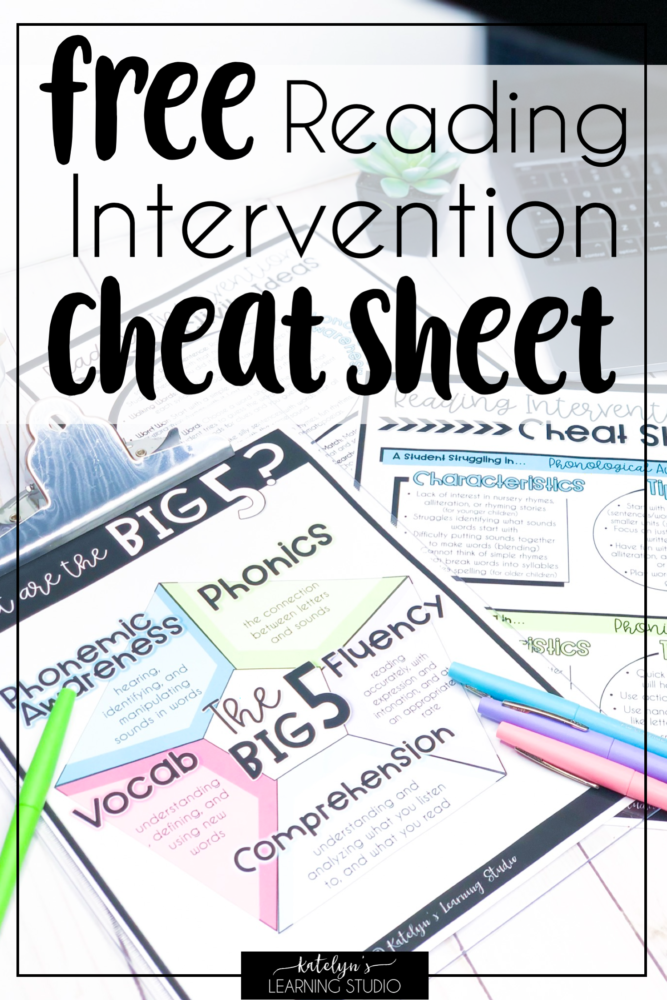Intervention in Reading

Make your intervention in reading effective and stress free!
Intervention in reading can be the difference that changes students’ path. What teacher doesn’t want to be that difference? To teach a child to read, is to give them a bright future full of hope and endless possibilities. But sometimes teaching a child to read isn’t that simple.

Ease your teaching stress with these reading intervention tips!
Think of your struggling readers. There is nothing harder than watching a student you deeply care about try so hard, but struggle to learn how to read. Or, a student who has gone through so much failure and discouragement, that they don’t even try anymore. How heartbreaking is it to watch those students flounder, and to want so desperately to help them, but not know how?
Sometimes, all the “normal” teaching techniques won’t cut it. Sometimes reading intervention is needed.
Now, this sounds like another thing to squeeze into your schedule, or another plate to juggle, but it can be simple, and can be easily integrated into your natural day.
I made a completely free Reading Intervention Cheat Sheet to specifically help you for this reason! I want all teachers to have the tools they need to make intervention in reading a successful and natural part of their teaching.
This cheat sheet:
- gives you a quick, at a glance guide for intervention in reading
- helps you focus down on what your students need
- shows you how to reach them, in ways that work.
How many times have you sat with a student, knowing they need you but not knowing how to help? Or how many times have you had a small group lesson with your lowest readers, where the students are doing things, but nothing seems to be helping? Just an endless treadmill of going through the motions but not making any progress.
You don’t need to be on that treadmill anymore. No more guessing what your struggling readers need. No more trying to fill the time with worksheets and activities that are not giving results. Make the most out of each precious minute with the students who need you most. All you need are these two steps to transform your reading interventions into something magical.
The most important steps to help you reach your struggling readers are to:
How to Help your Struggling Readers
- Know your students
- Figure out WHO needs your help
- Find out WHERE they need your help
- Have easy reading intervention strategies already in your back pocket
- Have it be second nature when you have a spare moment, or are working one-on-one with a student
Struggling Readers

Use these characteristics lists to help you identify struggling readers.
The first step is to identify who your struggling readers are. Sometimes it is very obvious when students struggle, but other times they can slip through the cracks. It’s important to be aware of the common characteristics associated with each area in reading. They can be your first warning signs that a student needs help.
There are 5 areas in reading (called The Big 5), and each area is vital to reading success. Intervention in reading is important or each of those areas.
This cheat sheet shows you common characteristics of students struggling in each of those areas, so you can easily identify your struggling readers. It gives you specific behaviors that students can display that give you clues to where they really need your help.
Honestly, this is one of my favorite parts about this cheat sheet. This is the problem-solving part, putting the pieces of the puzzle together to get the bigger picture. You spend so much time each day reading with your students, you almost always notice these little behaviors, but now you can actually do something about them because you know what they mean.
Intervention Reading Strategies

Here are some reading strategies and tips for each of the reading skills.
In addition to knowing who your struggling readers are and where they need your help, you need to know HOW to help them.
Intervention in reading is not just random reading exercises thrown at a student in hopes something will stick. There are certain intervention reading strategies that work with each reading area. I wanted to give you a quick and simple list of general tips that work to reach struggling readers in each area.
These intervention reading strategies can help guide your planning for intervention in reading, and help you know what direction to go in to help your students. They are meant to be a general guide for your intervention in reading. Use them in your reading interventions, as accommodations in your whole class differentiated instruction, or just in your everyday teaching habits.
The tips in the reading intervention cheat sheet are based off of how each skill is gained, and follow these reading intervention principles:
Reading Intervention Principles
- Skills are gained in sequential order
- You can’t skip the basics and foundation, and jump to the advanced stuff. Start basic and work your way up.
- Interventions should be targeted
- Focus on what the desired skill is, and make sure your interventions are actually modeling and practicing that skill
- Make every student feel successful
- This goes with the first principle, but make sure you are doing activities on an appropriate level for that student. Make sure they can succeed.
- Foster a love of reading
- As essential as skills and progress are in reading are, the most important part is that the student learns to actually enjoy reading. That is when the magic happens!
If you are interested in some more general tips for intervention in reading, check out this blog post where I go over 6 tips you can use in all of your interventions that will actually make them work. If you are having trouble seeing success in your intervention in reading, it’s a great place to start troubleshooting and looking for different tips to try.
Intervention Reading Activities

So many reading intervention activities and ideas to help your struggling readers!
You know how to find WHO your struggling readers are, WHERE they need help, and HOW to help them… now WHAT do you do to actually help them??
Here’s where the action is, and here’s where the magic happens. You actually put into use all of your planning for intervention in reading, and watch your students grow.
Also, here is where it is very easy to fall short because honestly, “Intervention in Reading? Ain’t nobody got time fo’ dat!”
I know, it is vitally important, but feels almost impossible to fit in. So what’s the solution?
I wanted to give you an easy fix for this too. Something that is so helpful is to have reading intervention activities ready to go in your “back pocket”, so if you have a time where the class is working independently, you can pull a student back and just do a quick activity.
It doesn’t need to be elaborate, all they need is practice—good, targeted, specific practice, but it can be simple.
So, here on the cheat sheet is a list of simple, easy activities that you can have on hand to pull out and use in your reading interventions. Most of them are no or little prep, and all of them can give your student meaningful practice in the area they need it.
If you want even more activity ideas, you can check out this blog post of my Ultimate List of Reading Intervention Activities. It has tons of ideas, all organized by learning styles so you can find what fits your students’ needs best.
Teacher Tip

This teacher tip is so simple, but a life saver!
Here’s a quick tip that I love for getting the most out of this cheat sheet. How many papers do you have printed out that could be useful, but are stuffed into a pile somewhere and you have no idea where they are?
Loose papers are not always your friend, and our goal is to make intervention in reading EASIER and a natural part of your teaching.
So, here’s a teacher tip for easy use:
- print out the pages half size (2 to a page)
- laminate them
- cut them out
- put them on a binder ring
And there you have it, an easy-to-access flip book of tips!
Keep the flip book at your guided reading table or in your reading intervention toolbox, and pull out for a quick glance whenever you need it.
Make your Intervention in Reading a success!
All students need a champion, someone who will fight for them every time. Be the difference for your struggling readers. Be the one who not only cares, but who does something about it.
DON’T beat yourself up and stress out over intervention in reading, but DO make your life a little easier and download this Reading Intervention Cheat Sheet. It can help you in your journey to be the difference!
Happy teaching and reading!


